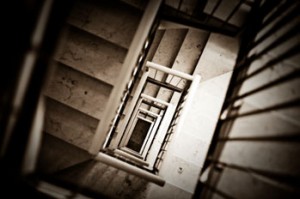By Zachary Turpin www.bookofodds.com
The Burj Khalifa was practically made to inspire a fear of heights. At 2,717 ft and 160 stories, the building formerly known as the Burj Dubai is the tallest building in Dubai, in Asia, and on the planet—it is literally the tallest freestanding thing ever made. And on February 8, 2010, 15 of its visitors found themselves stuck in the highest elevator in the world for 45 minutes. On the 129th floor.
 There is no word for the fear of elevator travel. Words exist for the fear of heights (acrophobia) and the fear of enclosed spaces (claustrophobia), but somehow “acroclaustrophobia” just doesn’t seem to cover it. An elevator is, after all, a small metal room hung over a great deal of empty space—sometimes over 1,000 feet of it. It’s little wonder few, if any, are glass-bottomed. But even with comfortable decor, air conditioning, soothing music, and—thankfully—opaque flooring, elevators still terrify many of us.
There is no word for the fear of elevator travel. Words exist for the fear of heights (acrophobia) and the fear of enclosed spaces (claustrophobia), but somehow “acroclaustrophobia” just doesn’t seem to cover it. An elevator is, after all, a small metal room hung over a great deal of empty space—sometimes over 1,000 feet of it. It’s little wonder few, if any, are glass-bottomed. But even with comfortable decor, air conditioning, soothing music, and—thankfully—opaque flooring, elevators still terrify many of us.
Is it the altitude? The odds an adult is afraid of heights are 1 in 2.78. Or enclosed spaces? The odds an adult is afraid of enclosed space are 1 in 2.94. Even just being alone in an elevator frightens people: 1 in 10 adults is afraid of that. But why? When and where did this fear take root?
The idea of the lift is thousands of years old. Vitruvius, a Roman architect whose Vitruvian Man was popularized by Leonardo da Vinci, writes that Archimedes built a proto-elevator in 236 BC. Precursors of the modern elevator include the screw-lift (invented in Russia in 1793), the dumbwaiter (a hand-cranked shuttle popularized by Thomas Jefferson), and the “ascending room” (first constructed in London in 1823). But it wasn’t until 1852 that a man in Yonkers, NY, conceived of the device as we know it today: the safety elevator. His given name was Elisha, and today, his last name can be seen on the threshold of countless elevators worldwide: OTIS.
In 1857, the first public safety elevator was installed in the SoHo neighborhood of Manhattan, in the building where Mary Todd Lincoln shopped for china. It cost $300 to install, and moved at 0.67 feet per second—roughly 0.5 miles per hour, or four floors a minute. It is still there, and still working.
Elevator engineering, properly called the “vertical transportation industry,” has come a long way in a century and a half. Today, passenger elevators can ascend to the height of the Burj Khalifa, taking the 160 stories in stages and traveling up to 25 mph. It’s little wonder that during that trip the imagination can run wild. After all, if an elevator can rise at 25 mph, how much faster could it fall?
As it turns out, safety elevators virtually never fall. They are over-engineered in the extreme: a typical passenger elevator is hoisted (by counterweight) with six or eight steel cables. Each cable is designed to hold an elevator’s full weight plus an extra 25%, on its own. All but one cable could snap with no vertical consequence. If the last cable breaks, though, elevators do what Otis designed them to do: they engage safety brakes, which stop a freefall within just a few feet.
It is almost impossible for a cable-borne safety elevator to plummet to the bottom. Almost. The last time it happened in the 20th century was in 1945, in the Empire State Building. The circumstances were extreme, to say the least. A B-25 Mitchell bomber, lost in heavy fog over New York, crashed into the skyscraper’s 79th floor. During the rescue effort, Betty Lou Oliver, an elevator attendant badly burned by the crash, was placed in an elevator to be lowered to street level. Unbeknownst to all, the plane had severely damaged the elevator’s safety cables—they broke. The elevator plunged more than 75 stories. That’s over 1,000 feet, straight down.
And, believe it or not, Oliver survived. She still holds a Guinness World Record.
It was another 56 years before another elevator would freefall in America, and the location and cause were, again, exceptional—it was September 11, 2001, in the World Trade Center.
The odds a person will die in an elevator accident in a year are 1 in 10,440,000. Most accidents that do occur happen either sans elevator (e.g. stepping into an empty elevator shaft) or to elevator maintenance workers. Elevator-related deaths—and whether this is comforting or disquieting depends on how you look at it—are about as likely as a plane crash. Not dying in a plane crash, which is even less likely. Just the crash itself.
You are far likelier to get stuck in an elevator than plunge to your death. In 1999, Nicholas White, a Manhattan production manager for BusinessWeek, got trapped in one—alone—for 41 hours. It was all caught on security tape, and White’s full ordeal, fast-forwarded for brevity, was widely circulated.
And one imagines elevator-phobes everywhere began carrying bottled water, toilet paper, and a book—just in case.














